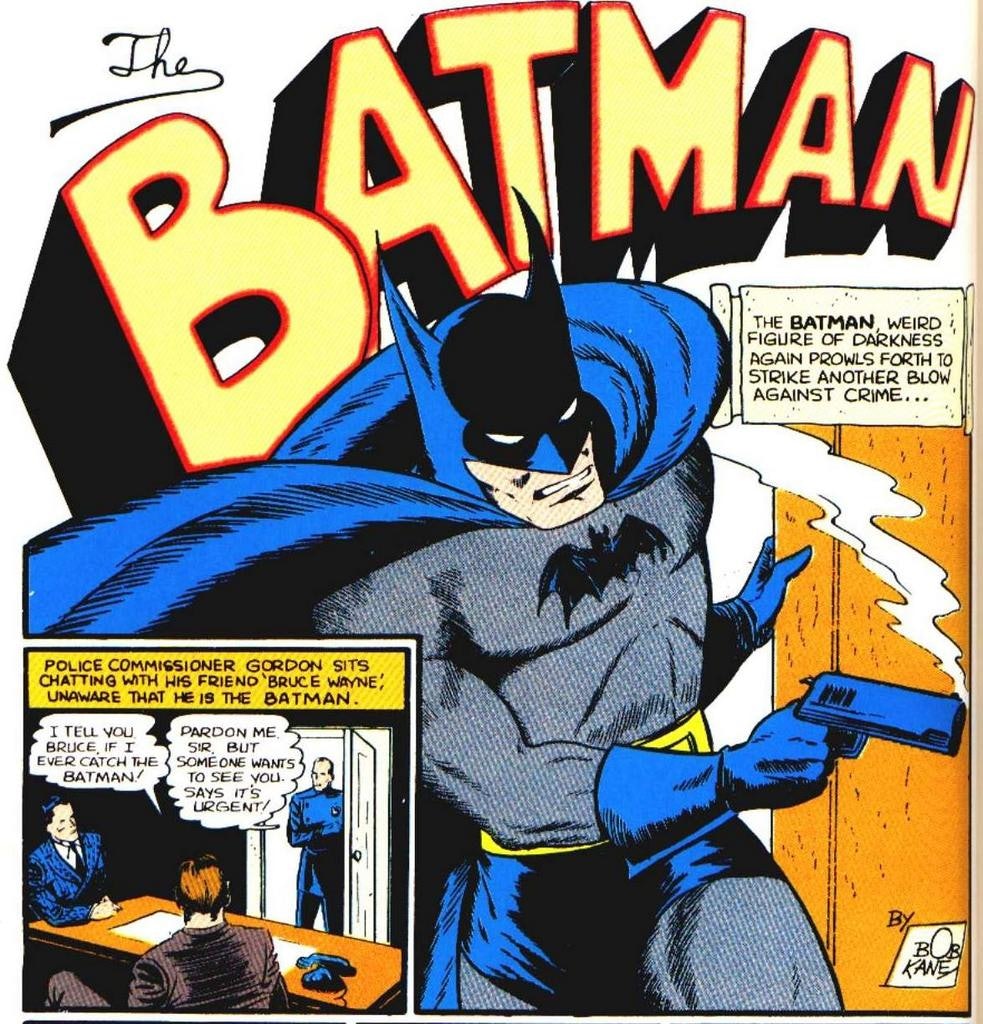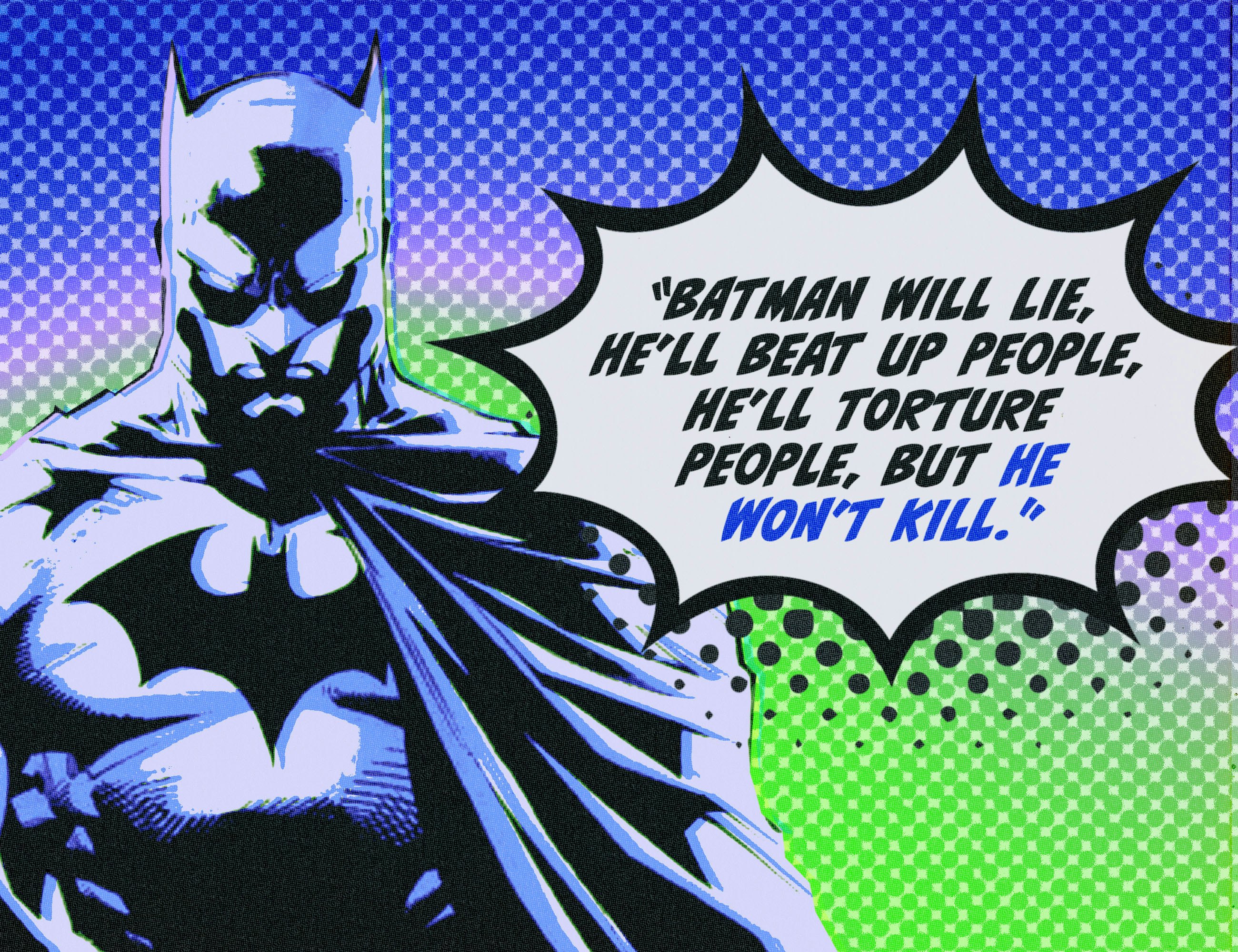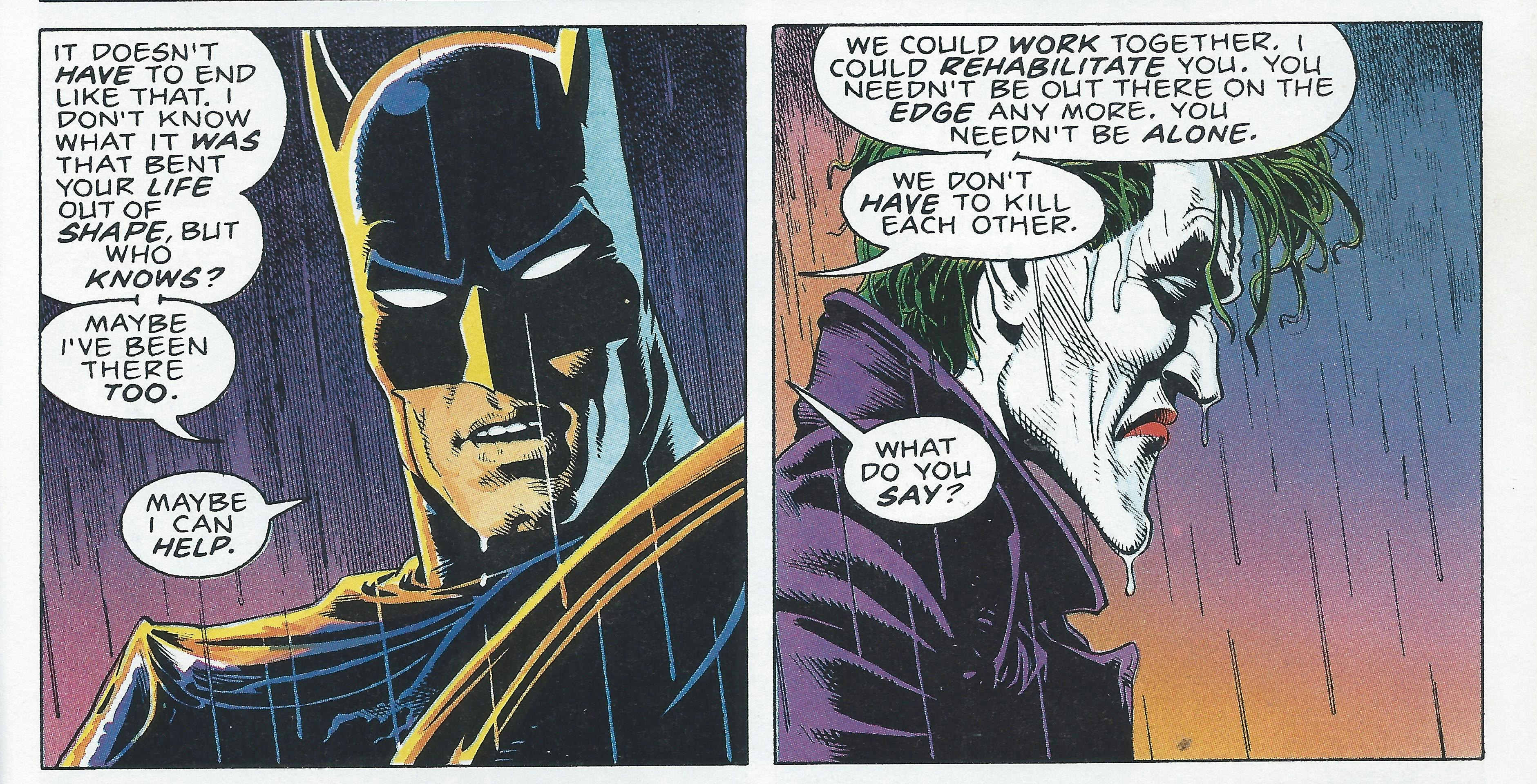
The earliest version of Superman was straight-up evil.
Before Jerry Siegel and Joe Shuster sold the character to DC, they were a pair of 1930s high school students with a fanzine called Science Fiction, which featured a dystopian short story called “The Reign of the Superman.” It wasn’t really about the Superman we know, but instead, a man who becomes evil after acquiring superpowers.
“The Reign of the Superman” was a one-off story that ended in tragedy, but it may have taught Siegel and Shuster a valuable lesson: the dissolution of one’s morals isn’t a repeatable formula. To bring readers back over and over again, heroes needed to be reliable. They needed a code of ethics. They needed morality.

For nearly a century, Superman, Batman, and Wonder Woman (known collectively as “The Trinity”) have represented what it means to be a hero and laid out the rules for everyone else to follow. So it’s worth interrogating where their morality comes from and how it’s changed over the decades. Batman famously doesn’t kill — except he used to and sometimes still does. Superman isn’t always the beacon of righteous justice we imagine. And Wonder Woman, well, let’s just say Wonder Woman is complicated.
But when you look closely at the evolving and shifting morality of DC’s Trinity, one thing becomes clear: It’s never been as fixed as you might think. From rewritten origin stories to changing cultural norms, the morality of Superman, Batman, and Wonder Woman can feel as malleable as Clayface on a hot summer day. But while there’s no clear ethical arc carrying our heroes from evil to good (or good to evil), the many changes they’ve experienced along the way reveal a surprising amount about the nature of superheroism itself.
Shifting Origin Stories

The first official version of Superman (Action Comics #1 in 1938) doesn’t resemble the beacon of morality we think of today, either. Back then, Superman’s aims were more like Batman’s. In his debut, Superman shakes a mobster out of his sedan and hangs another criminal from a telephone wire.
“He would slam slumlords. He would go after the wife beaters, and give them a taste of the wrong medicine. He stepped over the lines a lot back then,” entertainment journalist and historian Ed Gross tells Inverse.

Gross is also the author of the 2023 Superman oral history book Voices From Krypton, and his research reveals the Man of Steel wasn’t always so high and mighty.
“He wasn’t that guy yet,” Gross says. “He came out of the Depression, out of very rough and tumble times when people were being oppressed and they needed somebody to fight back for them because they couldn't. So he did.”


A few years later, the world changed, and superheroes changed with it.
“The Second World War pushed everybody into a more rigid patriotism — truth, justice, and the American Way showed up in 1942,” Austin Grossman, an author who writes literary novels about realistic superheroes, tells Inverse.
Marvel wasn’t any different. In his first-ever comic book cover, Captain America famously punches Adolf Hitler in the face. After the war, DC and Marvel both slowly walked back that shift toward patriotism, but the idea that superheroes are in the moral right regardless of their action persists — even if fans don’t always agree.
The most squeaky-clean Superman of them all, Christopher Reeve, was totally fine with sending General Zod to his death in 1981, but it happened offscreen. When Supes snapped Zod’s neck in 2013’s Man of Steel it caused an uproar, because some fans believed Superman should never kill. But Superman had done the same thing in the comics and films before.
Most fans think Superman is the ultimate good guy, while Batman has flexible morals — as Batman said in Hush Vol. 2 in 2004, “Deep down, Clark’s essentially a good person, and deep down, I’m not.”
But back in 1939, the difference wasn’t so obvious. At the time, the only thing separating Batman and Superman, in terms of their moral styles of crime-fighting, was that Batman shot people with a gun, and Superman didn’t. And then, seemingly overnight, Batman started following a new set of rules.
“Batman will lie, he’ll beat up people, he’ll torture people, but he won’t kill,” Mark D. White, Professor of Philosophy at The College of Staten Island/CUNY, and an expert in the field of superhero ethics, tells Inverse.

Batman is a consequentialist, someone who makes moral judgments by calculating the best possible (or least horrible) option. But because he’s not willing to kill, he’s not a pure consequentialist.
“He is what we call a constrained consequentialist,” White says, “generally a consequentialist, except there are certain lines he won’t cross. But that describes how Superman behaves as well. They’re not that far apart.”
It wasn’t until November 1939, a full nine months after his introduction, that Batman co-creator Bob Kane penned “Legend: The Bat Man and How He Came to Be,” a two-page essay that revealed Batman’s whole motivation was connected to his hatred of gun violence. In essence, Batman’s morality, or at least his very specific code of ethics (“No guns. No killing,” he rasps in The Dark Knight Rises) was retroactively invented.

As Jill Lepore writes in her New Yorker essay “Batman’s Gun,” this decision created an entirely new backstory (and moral center) for Batman. “Superheroes weren’t soldiers or policemen. They were private citizens,” Lepore wrote. “They shouldn’t carry concealed weapons. Villains carried guns.”
Superman's origin story also got a crucial retcon early on. At first, the comics (and radio shows and cartoons) said Superman was raised in an orphanage. It wasn’t until Clark Kent got his adoptive parents that the character started to move away from the gray area of an avenging vigilante. As Gross points out, “The thing that got added as his time went on was the idea of what got instilled in him by Jonathan and Martha Kent. That element came later.”

In 1940, Wonder Woman sidestepped the somewhat binary Superman/Batman approach to morality altogether. Unlike the other members of the DC Trinity, Diana didn’t grow up in human society. She spent her early days in the utopia of Themyscira. So when she’s faced with a moral dilemma, it’s taken entirely at face value. She’ll beat up or manipulate anyone who gets in her way.
Wonder Woman’s belief in female supremacy often shines through — especially when she’s up against men — but even then, she’s hesitant to kill. She didn’t need a “no-kill rule” like Batman. Instead, she believed in trying everything at her disposal.
Wonder Woman’s early morality is best explained by Immanuel Kant’s concept of the “categorical imperative,” a set of unconditional moral imperatives that all people follow. However, her moral foundation can sometimes seem alien. (There are countless examples of Wonder Woman having the same level of contempt for the wage gap as she does for organized crime, for example.)
“The Amazons could have developed all this same moral theory that we had in ‘The Man's World,’ or whatever you want to call it,” White says, “but that doesn't mean they'd implement those ideas in the same way because their culture was very different.”
According to Grossman, Wonder Woman is probably the most moral of the Trinity for the simple reason that she’s the one who will most likely be thinking about how to fix these problems in the long term: “If some mega-yacht is sinking, what does each one do? Superman says, ‘Yeah, save it, obviously.’ Batman: ‘Well technically no crime is occurring, but sure.’ Wonder Woman: ‘Yes, but I’m going to have a little chat with the service workers while I’m at it.’”
Giving Up Your Powers

The impact of the Greatest Generation’s patriotism on the big three is fairly clear in the ‘50s, and well into the ‘60s and ‘70s. For the most part, the post-WWII versions of Superman, Batman, and Wonder Woman created the moral templates by which they’re still judged today. When someone refers to a “classic” or “traditional” version of these characters, they’re almost certainly referring to the Silver Age. This was the era in which Adam West’s Batman espoused PSAs about good citizenship, and “truth, justice, and the American way” was assumed to be part of the basic DNA of all of DC’s greatest heroes.
Sometimes the ultimate way to balance a superhero’s powers is to take those powers away entirely. In the 1960s run of Wonder Woman, Diana gives up her powers after her boyfriend is found guilty of a murder he didn’t commit so she can stay on Earth and investigate the case. Wonder Woman is at her least powerful and doesn’t have the same freedom to make decisions of morality. Her main defense is karate, and she’ll use it against anybody from hired goons to wayward teens.


Something similar happens in the 1981 film Superman II, in which Clark Kent is encouraged by holographic ghosts of his Kryptonian parents to give up his powers to live an authentic life with Lois Lane. Superman’s moral decision is linked to the idea of honesty. He has to stop living a lie to devote himself to Lois. This may seem like a weird technicality — in other stories, Lois knows that Clark is Superman and seems fine with it — but what Clark’s choice in Superman II suggests is a moral imperative in the extreme. If Superman is going to stop lying to Lois, he has to stop lying to everyone.
The trope of giving up superpowers for the person you love created a unique moral test, one that Superman, Wonder Woman, and Batman tend to fail over and over again. Because Batman has no powers, his anonymity becomes the only thing he can sacrifice. But even the gee-golly Adam West version of the character was loathe to remove his mask. Whenever Batman does reveal himself to others — just like Clark and Diana losing their powers — we know it’s only a matter of time before he puts back on the cape and cowl.

Watchmen, Alan Moore’s grand deconstruction of the entire superhero genre, offers perhaps the best example of a superhero giving up their powers in Dr. Manhattan, Moore’s all-knowing and all-powerful perversion of Superman. Dr. Manhattan’s mere existence acts as a kind of nuclear deterrent, imposing American might on the rest of the world. While the character eventually evolves beyond a need for humanity and tries to step away, his absence and the chaos it creates are more dangerous than his direct involvement. Like Superman, Batman, and Wonder Woman, his existence creates an ethical trap he can never escape.
Modern Batman

Batman went through further dramatic changes starting in the 1980s. Frank Miller’s famous 1986 storyline The Dark Knight Returns depicted the Caped Crusader as the sole provider of superheroics in a depressing future where Superman serves as a brutal government enforcer. Then, in 1987, spearheaded by Jim Starlin, DC’s primary continuity published A Death in the Family, in which the Joker brutally kills the second version of Robin, Jason Todd.
In the late ‘80s and early ‘90s, harder-edged versions of Batman started to make their way into the mainstream, non-comic-book-reading population, too. In Tim Burton’s Batman (1989), Bruce Wayne was clearly OK with murder. The Joker is killed at the end of the first film, and Michael Keaton’s Batman is ruthless toward the Penguin in Batman Returns, too. Even Val Kilmer and George Clooney’s derided Batmen don’t seem as morally clear as Christian Bale’s take in Christopher Nolan’s Dark Knight trilogy. When Ben Affleck’s Batman revealed he had machine guns in his Batmobile, some fans cried foul, and yet, the notion that Batman was extremely anti-gun, is, as we know, an inconsistent feature of the character. Batman is against corruption, but he’s also about getting the job done.

The idea that Superman and Batman have to deal with corruption in government and grapple with the letter of the law and the spirit of the law is embedded into their characters, but certainly more pronounced after the 1980s and well into the 21st century. In the 2003 arc “Public Enemies,” Batman and Superman have to team up simply because the corrupt U.S. President — Lex Luthor — declares both enemies of the state. Here, the idea of self-preservation and personal morality is conflated. Superman and Batman may quibble over the details of how to get the job done, but they can all agree that if Lex Luthor is trying to have them killed, then they both must be doing something right.
Meanwhile, with his work done and Batman returned to his grim avenger roots, Frank Miller jumped ship to Dark Horse Comics where he created Sin City in 1991. This ultra-violent tribute to the work of pulp fiction trailblazer Mickey Spillane takes Miller’s vision of the Caped Crusader a step further, unleashing the hulking, homicidal anti-hero Marv on a Gotham-esque city full of crime, corruption, and femme fatales. Marv’s leather jacket often resembles a cape. He’s basically Batman, just without the no-kill rule.
Speaking of which...
Can Superheroes Kill?

In July 2005, just one year before Marvel tore the Avengers apart in a battle over superhero ethics titled Civil War, DC Comics pitted Wonder Woman against her toughest foe yet. In Infinite Crisis #1, supervillain Maxwell Lord manages to gain mind control powers over Superman. Max forces Wonder Woman into a vicious fight with Supes, who believes Diana has just murdered Lois Lane.
Diana tries everything to subdue Kal-El — even slitting his throat with her lasso — but it’s not enough. So Wonder Woman takes a different approach. She wraps the lasso around Max. Compelled to tell the truth, he reveals that no matter what, he can get Superman to kill whoever he wants. She demands to know how to free Superman. “Kill me,” Max responds.
Without another word, she snaps his neck. For a hero who began as a positive female role model, this was her most merciless kill yet. A year later, in Wonder Woman #600, she says, “Don’t kill if you can wound, don’t wound if you can subdue, don’t subdue if you can pacify, and don’t raise your hand at all until you’ve first extended it.” But at that moment, murder was the only option.

It’s in these moments that Wonder Woman’s morals become completely distinct from Batman and Superman’s. She’s willing to compromise on her principles of not killing if it means preventing deaths in the future.“It’s called threshold deontology,” Mark D. White says. “You follow whatever the moral rules or principles — in this case: do not kill — until the costs of following that reach an unacceptable level.”
Wonder Woman’s goal isn’t moral purity, it’s harm reduction. It's here that Batman and Wonder Woman probably have more in common with each other than they don’t. Superman exists for us to pose the question of an absolute right, a categorical imperative by which everyone can and should act.
But Batman, Wonder Woman, and Superman don’t just exist in the same story over and over again. Each new comic book, TV show, and movie changes the characters in surprising ways. Whether it's the introduction of Ma and Pa Kent, the bizarre decision to strip Wonder Woman of her powers in the Silver Age of DC Comics, or the controversial choice to give Batman a gun (again) in Batman v Superman, these stories all come together to create three characters whose evolving morality is complex and hard to pin down, or, put another way, human.
Inverse's 2024 Superhero Issue, guest edited by Zack Snyder, explores the genre for what it is: a profound commentary on our shared human experience. Dive into the full issue here.
About the artist: Jared Purrington is a storyboard artist and illustrator. His credits include Ratatouille, Man of Steel, Batman v Superman: Dawn of Justice, Suicide Squad, Terminator: Dark Fate, Wonder Woman 1984, Army of the Dead, and Rebel Moon Part 1. He is also the producer of two films: Underwater and Land of Bad.







